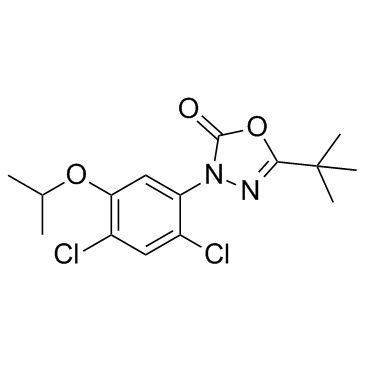Oxadiazon

Oxadiazon structure
|
Common Name | Oxadiazon | ||
|---|---|---|---|---|
| CAS Number | 19666-30-9 | Molecular Weight | 345.221 | |
| Density | 1.3±0.1 g/cm3 | Boiling Point | 417.0±55.0 °C at 760 mmHg | |
| Molecular Formula | C15H18Cl2N2O3 | Melting Point | 88-90°C | |
| MSDS | Chinese USA | Flash Point | 206.0±31.5 °C | |
| Symbol |

GHS09 |
Signal Word | Warning | |
|
The effect of protoporphyrinogen oxidase inhibitors on microsomal and mitochondrial cytochromes.
Obes. Res. 3 Suppl 5 , 785S-788S, (1995) Neurological dysfunction is a characteristic feature of acute porphyrias, unexplained until now. One of the possible explanations is a deficiency of heme in the central nervous system, caused by a block in porphyrin biosynthesis. To test this possibility, the... |
|
|
Mining biologically-active molecules for inhibitors of fatty acid amide hydrolase (FAAH): Identification of phenmedipham and amperozide as FAAH inhibitors
Bioorg. Med. Chem. Lett. 19 , 6793-6, (2009) The screening of known medicinal agents against new biological targets has been shown to be a valuable approach for revealing new pharmacology of marketed compounds. Recently, carbamate, urea and ketone inhibitors of fatty acid amide hydrolase (FAAH) have bee... |
|
|
Herbicide-induced experimental variegate porphyria in mice: tissue porphyrinogen accumulation and response to porphyrogenic drugs.
Can. J. Physiol. Pharmacol. 75(10-11) , 1181-7, (1997) Administration of oxadiazon or oxyfluorfen (1000 ppm in the diet) to male BALB/c mice for 9 days resulted in experimental porphyria, resembling the acute phase of human variegate porphyria. Urinary concentrations of 5-aminolevulinic acid and porphobilinogen r... |
|
|
Resistance of a soybean cell line to oxyfluorfen by overproduction of mitochondrial protoporphyrinogen oxidase.
Pest Manag. Sci. 57(8) , 743-8, (2001) The diphenyl ether herbicide oxyfluorfen (2-chloro-4-trifluoromethylphenyl 3-ethoxy-4-nitrophenyl ether) inhibits protoporphyrinogen oxidase (Protox) which catalyzes the oxidation of protoporphyrinogen IX (Protogen) to protoporphyrin IX (Proto IX), the last s... |
|
|
Effect of the herbicides oxadiazon and oxyfluorfen on phosphates solubilizing microorganisms and their persistence in rice fields.
Chemosphere 53(3) , 217-21, (2003) A field experiment has been conducted with two herbicides viz. oxadiazon [5-terbutyl-3-(2,4-dichloro-5-isopropoxyphenyl)-1,3,4-oxadiazol-2-one] and oxyfluorfen [2-chloro-1-(3-ethoxy-4-nitrophenyl)-4-(trifluoromethyl) benzene] at rates of 0.4 and 0.12 kg a.i. ... |
|
|
Effect of systemic herbicides on N2-fixing and phosphate solubilizing microorganisms in relation to availability of nitrogen and phosphorus in paddy soils of West Bengal.
Chemosphere 65(6) , 1082-6, (2006) A field experiment has been conducted with four systemic herbicides viz., butachlor [N-(butoxymethyl)-2-chloro-2',6'-diethyl-acetanilide], fluchloralin [N-(2-chloroethyl)-(2,6-dinitro-N-propyl-4-trifluoromethyl) aniline], oxadiazon [5-terbutyl-3-(2,4-dichloro... |
|
|
Developmental studies on Drosophila melanogaster glutathione S-transferase and its induction by oxadiazolone.
Insect Biochem. Mol. Biol. 25(10) , 1115-9, (1995) Glutathione S-transferase activity toward 1-chloro-2,4-dinitrobenzene was detected in various developmental stages of Drosophila melanogaster. The specific activity of the enzyme was 110, 35, 25 and 15 nmol/min/mg protein in crude extracts prepared from eggs,... |
|
|
Degradation of oxadiazon in a bioreactor integrated in the water closed circuit of a plant nursery.
Bioresour. Technol. 99(7) , 2177-81, (2008) Hardy ornamental nursery stock (HONS) use fertigation as a rational supply of nutrients all along the growth cycle of plants. Nevertheless, that frequency of irrigation increases the risks of nutrient and herbicide leaching and subsequent contamination of the... |
|
|
Photodegradation of the herbicides butachlor and ronstar using natural sunlight and diethylamine.
Bull. Environ. Contam. Toxicol. 64(6) , 780-5, (2000)
|
|
|
Herbicides and the microtubular apparatus of Nicotiana tabacum pollen tube: immunofluorescence and immunogold labelling studies.
Toxicol. In Vitro 15(2) , 143-51, (2001) Herbicides are chemical compounds widely used in agriculture. As their intensive application is becoming a cause of environmental pollution, detailed and more sophisticated investigations are needed to understand better their consequences at the biological le... |